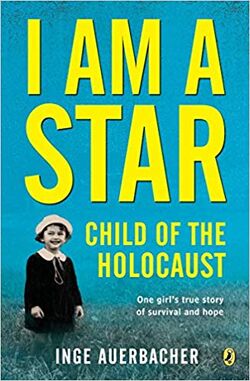Inge Auerbacher (F / Germany, 1934), Holocaust survivor
Inge Auerbacher (F / Germany, 1934), Holocaust survivor.
- KEYWORDS : <Germany> <Theresienstadt> / <Liberation of Theresienstadt> / <United States>
- MEMOIRS : I Am a Star (1986)
Biography
Inge Auerbacher was born in Kippenheim, Germany on Dec 31, 1934. Deported with her parents to Theresienstad, where they spent nearly three years until liberation on May 8, 1945. After the war, she immigrated with her family to New York City in May 1946. She graduated from Queens College and spent 38 years working as a chemist. Wrote several books on the Holocaust.
Book : I Am a Star (1986)
- I Am a Star: Child of the Holocaust (New York, NY: Prentice-Hall Books for Young Readers, 1986)
"The author's reminiscences about her childhood in Germany, years of which were spent in a Nazi concentration camp. Includes several of her original poems ... Inge Auerbacher’s childhood was as happy and peaceful as that of any other German child—until 1942. By then, the Nazis were in power, and because Inge’s family was Jewish, she and her parents with sent to a concentration camp in Czechoslovakia. The Auerbachers defied death for three years, and were finally freed in 1945. In her own words, Inge Auerbacher tells her family’s harrowing story—and how they carried with them ever after the strength and courage of will that allowed them to survive."--Publisher description.
USHMM's ID Card
Inge was the only child of Berthold and Regina Auerbacher, religious Jews living in Kippenheim, a village in southwestern Germany near the Black Forest. Her father was a textile merchant. The family lived in a large house with 17 rooms and had servants to help with the housework.
1933-39: On November 10, 1938, hoodlums threw rocks and broke all the windows of Inge's home. That same day police arrested her father and grandfather. Inge, her mother and grandmother managed to hide in a shed until it was quiet. When they came out, the town's Jewish men had been taken to the Dachau concentration camp. Her father and grandfather were allowed to return home a few weeks later, but that May her grandfather died of a heart attack.
1940-45: When Inge was 7, she was deported with her parents to the Theresienstadt ghetto in Czechoslovakia. When they arrived, everything was taken from them, except for the clothes they wore and Inge's doll, Marlene. Conditions in the camp were harsh. Potatoes were as valuable as diamonds. Inge was hungry, scared and sick most of the time. For her eighth birthday, her parents gave her a tiny potato cake with a hint of sugar; for her ninth birthday, an outfit sewn from rags for her doll; and for her tenth birthday, a poem written by her mother.
On May 8, 1945, Inge and her parents were liberated from the Theresienstadt ghetto where they had spent nearly three years. They immigrated to the United States in May 1946.
USHMM Oral Interview
Inge Auerbacher discusses her prewar life in Kippenheim, Germany, where her orthodox Jewish family lived peacefully with Christians; her memories of Kristallnacht; the transports of Jews beginning in 1941, the 1942 deportation of her entire family to Theresienstadt; the “clean-up” of Theresienstadt done for the benefit of the Red Cross Commission and for a propaganda film; her liberation on May 8, 1945; arriving in the United States in 1946 aboard the Marine Perch; her work as a chemist with renowned scientist, Meyer Friedman; and her life’s work lecturing about the Holocaust and being a voice against bigotry.
Museum of Tolerance
EInge, the only child of Regina and Berthold Auerbacher, was born a year after the Nazis came to power. She lived in a small village in southern Germany where her father had his own textile business. Inge's father, a soldier in World War I, had been badly wounded and received the "Iron Cross" for bravery.
On the night of November 9-10, 1938, just before Inge's fourth birthday, countrywide acts of terror and destruction were carried out against Germany's Jews. Inge's father was arrested and sent to a concentration camp. After his release a few weeks later, the family realized the need to leave the country, but they had nowhere to go. They moved to her mother's home town. Inge's grandfather soon died, hurt by the country he loved so much.
Harsh restrictions were imposed and life became increasingly difficult. A former servant provided them with food. Inge could no longer attend the local public school. Six year-old Inge had to walk two miles to a larger town to catch a train in order to attend a Jewish school in Stuttgart. In 1941, she was forced to wear the yellow star, and was taunted by the other children on the train.
In late 1941, Inge, her parents and her grandmother were told to report for "resettlement." Her father, a disabled World War I veteran, obtained a postponement, but her grandmother was sent to Latvia where she was murdered.
On August 22, 1942, Inge and her parents were arrested and deported. Forced to leave all their possessions behind, they were sent to the Theresienstadt ghetto in Czechoslovakia. Inge and her parents were sent to the disabled war veterans' section of the ghetto where they were allowed to stay together. Conditions were horrendous. Food was scarce, sanitation was poor, and heating was inadequate. The ghetto was infested with disease-carrying vermin. Always hungry, Inge and her parents constantly lived with the fear that they would be deported to the death camps in Poland. In the spring of 1945, the Germans began building gas chambers in Theresienstadt, where they planned to kill all the remaining Jews. But on May 8, 1945, Soviet troops entered the ghetto and ten year-old Inge and her parents were freed.
